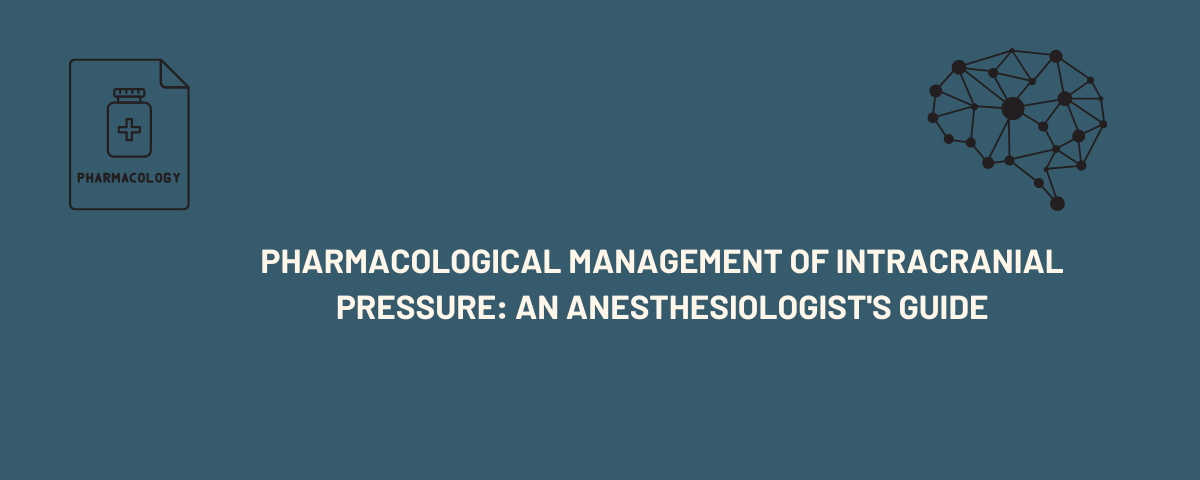Elevated intracranial pressure (ICP) is a critical concern in neurosurgical patients and those with traumatic brain injuries. Proper management of ICP is crucial to prevent secondary brain injury, maintain cerebral perfusion pressure (CPP), and ensure optimal surgical outcomes. This article provides a detailed review of pharmacological agents used in the management of ICP, focusing on propofol, thiopentone, isoflurane, desflurane, remifentanil, dexmedetomidine, and mannitol.
1. Propofol
- Dose: Induction: 1.5-2.5 mg/kg IV; Maintenance: 50-150 mcg/kg/min IV infusion
- Mechanism of Action: Propofol is a GABA-A receptor agonist that enhances inhibitory neurotransmission, leading to sedation, hypnosis, and a decrease in cerebral metabolic rate (CMR). This reduction in CMR leads to a corresponding decrease in cerebral blood flow (CBF) and ICP. Propofol also provides neuroprotective effects by reducing glutamate release and oxidative stress.
- Clinical Use: Propofol is widely used for the induction and maintenance of anesthesia in patients with elevated ICP. Its rapid onset and titratable nature make it ideal for neurosurgical cases, where fine control over anesthesia is essential. However, its vasodilatory effects can lead to hypotension, which may compromise CPP.
2. Thiopentone (Thiopental)
- Dose: Induction: 3-5 mg/kg IV; Barbiturate coma: 1-2 mg/kg/hr infusion (titrated to burst suppression on EEG)
- Mechanism of Action: Thiopentone is a barbiturate that enhances GABAergic transmission, resulting in sedation and decreased neuronal excitability. Like propofol, it reduces CMR and CBF, leading to a decrease in ICP. Thiopentone also has potent anticonvulsant properties, making it valuable in managing refractory seizures and reducing ICP in cases of status epilepticus or traumatic brain injury.
- Clinical Use: Thiopentone is often used in cases of refractory ICP elevation, where its potent cerebral protective effects are beneficial. However, due to its long duration of action and potential for immunosuppression and hypotension, its use is typically reserved for severe cases, such as in barbiturate coma therapy.
3. Isoflurane
- Dose: 0.5-1.5 MAC (Minimum Alveolar Concentration)
- Mechanism of Action: Isoflurane is a volatile anesthetic that decreases CMR and has neuroprotective properties by reducing excitotoxicity and oxidative stress. However, it causes cerebral vasodilation, which can increase CBF and potentially elevate ICP. Despite this, when used in conjunction with other ICP-lowering strategies (e.g., hyperventilation or osmotic diuretics), isoflurane can be safely used in neurosurgical anesthesia.
- Clinical Use: Isoflurane is often used for maintenance of anesthesia in neurosurgery, particularly when ICP control is needed. Its cerebral vasodilatory effects can be counteracted by other measures, such as hyperventilation, to reduce CBF and ICP.
4. Desflurane
- Dose: 0.5-1.5 MAC
- Mechanism of Action: Like isoflurane, desflurane decreases CMR while causing cerebral vasodilation. Desflurane is known for its rapid onset and offset, making it useful for procedures where quick emergence from anesthesia is required. However, similar to other volatile anesthetics, desflurane can increase CBF and potentially raise ICP.
- Clinical Use: Desflurane is preferred in scenarios where rapid postoperative recovery is desired, such as short neurosurgical procedures. Care must be taken to control CBF with adjunct measures like hyperventilation to avoid ICP elevation.
5. Remifentanil
- Dose: 0.1-1 mcg/kg/min IV infusion (adjusted based on response)
- Mechanism of Action: Remifentanil is a potent, ultra-short-acting opioid agonist that works on mu-opioid receptors, providing profound analgesia with minimal accumulation. While it does not directly lower ICP, remifentanil helps in maintaining hemodynamic stability during neurosurgery, thereby ensuring stable CPP.
- Clinical Use: Remifentanil is often used in combination with sedatives and anesthetics in neurosurgery for its ability to control pain and minimize the sympathetic response to surgical stimuli. Its rapid onset and short duration of action allow for precise control over anesthesia depth and postoperative wake-up.
6. Dexmedetomidine
- Dose: Loading dose: 0.5-1 mcg/kg IV over 10 minutes; Maintenance: 0.2-0.7 mcg/kg/hr IV infusion
- Mechanism of Action: Dexmedetomidine is a selective alpha-2 adrenergic agonist that provides sedation and analgesia without respiratory depression. It decreases sympathetic tone, leading to reduced blood pressure and heart rate, which can indirectly lower ICP. Dexmedetomidine also exerts neuroprotective effects through inhibition of excitotoxicity and reduction of inflammatory responses.
- Clinical Use: Dexmedetomidine is an excellent adjunct in neuroanesthesia, particularly for cases where light sedation is needed without compromising respiratory drive. It’s also beneficial in situations requiring neuroprotection and smooth emergence from anesthesia, as it does not cause significant hemodynamic instability or ICP spikes.
7. Mannitol
- Dose: 0.25-1 g/kg IV bolus (repeated as necessary based on ICP monitoring)
- Mechanism of Action: Mannitol is an osmotic diuretic that increases plasma osmolality, drawing water out of brain tissue and reducing cerebral edema. This results in a rapid decrease in ICP, typically within minutes of administration. Mannitol also improves microcirculation by decreasing blood viscosity, which can help restore cerebral perfusion.
- Clinical Use: Mannitol is commonly used in acute settings, such as traumatic brain injury or during neurosurgical procedures, to reduce ICP. Careful monitoring of electrolyte levels, particularly sodium, and fluid balance is essential, as mannitol can cause hyperosmolar states and dehydration.
Conclusion
Pharmacological management of elevated ICP is a cornerstone of neuroanesthesia. Each agent discussed—propofol, thiopentone, isoflurane, desflurane, remifentanil, dexmedetomidine, and mannitol—has specific mechanisms of action that can be leveraged to optimize outcomes in patients with increased ICP. An understanding of these drugs, their dosages, and their effects on cerebral hemodynamics is essential for tailoring anesthetic plans to the individual patient and surgical scenario. As always, continuous monitoring of ICP and CPP, along with the judicious use of these pharmacologic agents, is key to ensuring optimal patient outcomes.
For more detailed discussions and the latest evidence, visit optimalanesthesia.com.


